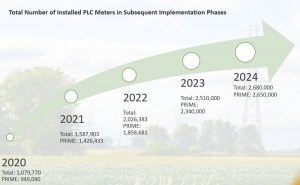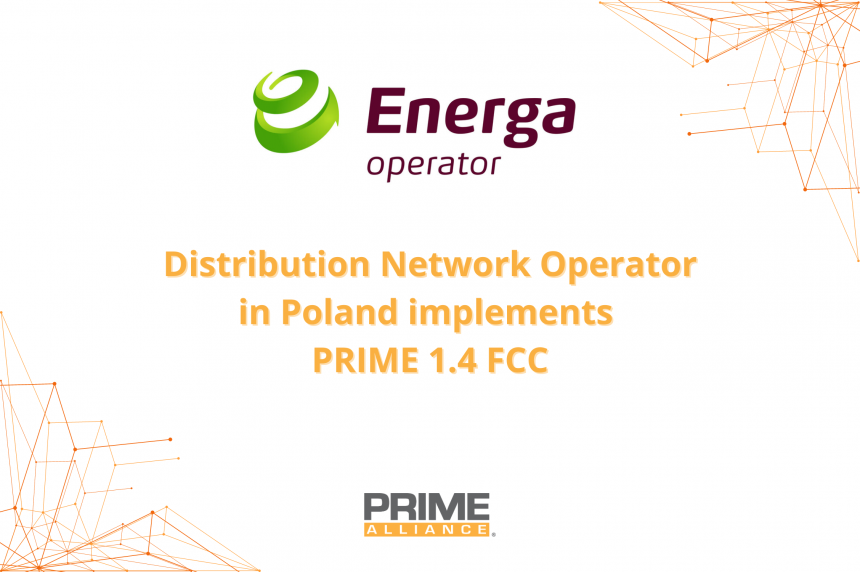ENERGA-OPERATOR SA – Distribution Network Operator in Poland implements PRIME 1.4 FCC
ENERGA-OPERATOR SA is one of the five Distribution Network Operators (DSO) in Poland, working in the northern and central part of the country. It supplies over 3,3 mil clients with an electrical power exploits a total of around 198 thousand km of power lines as well as around 65 thousand of transformer stations.
The project of implementing remote meter reading at the utility customers of ENERGA-OPERATOR SA has already begun in 2010. Installation of the first electric meters (around 800,000 of them) was held based on the designated geographic areas. Primal deployment incorporated a thousand meters, operating on SFSK technology. Further stages, i.e. 700 thousand meters including technology PRIME 1.3.6. The meters were installed in 3 stages in 2011-2015. Since 2020, remote reading meters, operating on PRIME 1.4 technology, are being installed as a part of legalization replacements and operational servicing in all transformer stations. Currently, ENERGA-OPERATOR SA is equipped with remote reading meters for nearly 2,7 million of their clients. In only 2023, around 450 thousand meters were installed. By the end of the year 2026, remote metering is to be extended to all clients.

As a part of the ongoing tendering procedures, two main suppliers of the meters were selected: PRIME, i.e. APATOR SA and SAGEMCOM Poland Sp. z o. o. Both manufacturers had to meet specific technical requirements for the products in the purchasing procedure. An important condition for the purchase of remote reading meters was the presentation of a meter sample and a meter sample with a modem for substitute communication and subsequent verification of the verification tranche before mass deliveries of the operation of meters in the distribution network system.
It is worth acknowledging the particular increase of photovoltaic installations throughout recent years, as well as the change in the EMC norm, which affected the growth of the number of recipients electronic devices and resulted in interfering with a CELENEC A, band used to transmit the measurement data. In this regard, ENERGA-OPERATOR SA has become widely utilizing the new PRIME 1.4. standard, with particular emphasis on the use of higher frequency bands. Maintaining communication with the meters and hubs installed in the network that support only PRIME 1.3.6. has become a challenge.
Realization and application of PRIME 1.4. channels 3-8
In order to restrict the implementation costs of PRIME 1.4. FCC and replace the currently utilized PRIME 1.3.6, a new approach has been developed and appended into the meters.
Electric meters, acquired by ENERGA-OPERATOR SA, are equipped with the PRIME 1.4 BC
(with a backward compatibility) in the CELENEC A band – channel 1, as well as a band plan involving a total of three channels (channel 1, channel 6 and channel 4). Moreover, in order to assure enhanced PLC signal in the three-phase meters, three 1-phase PLC couplers switched automatically are required. A choice of the listed channels has been selected based on power grid disturbance examination and test deployments of PRIME 1.4 in various configurations, conducted on the ENERGA-OPERATOR SA network.
Automatic channel selection in the meters, works according to the following procedure:
- The meter is installed in the network with the usage of PRIME 1.4 BC channel 1,
- The meter verifies whether there is a PLC available on the L1 phase, if communication is not obtained, it switches to the L2 and L3 phases in turn,
- If the meter doesn’t find communication in channel 1 (on any of the phases) it selects the next channel (channel 6) from the band plan, then re-verifies the phases L1, L2, L3 in turn,
- If the meter doesn’t find communication in channel 6 (on any of the phases) it selects the next channel (channel 4) from the band plan, then re-verifies the phases L1, L2, L3 in turn,
- If the meter doesn’t find communication PLC in any of the channels returns to channel 1 and searches the next phases and channels that are in the band plan.
- If the meter has a GSM substitute communication modem, it will switch to GSM when the search in channel 4 is completed. GSM technology is an alternate communication and is used only in 5% of installed meters.
There is a possibility for the user to set the channel by defining it on the data concentrator. The data concentrator, by being equipped with a spectrum analyzer, is able to present the user with the best possible options for channel / communication band selection.
Thanks to this solution, elaborated by the ENERGA-OPERATOR SA engineering team, and the co-participation of the meter’s manufacturers, the possibility of achieving high reading rate is now available.
In 2022, the Polish Government implemented into the Polish law, a Directive 2019/944 of the European Parliament and of the Council (EU) of June 5, 2019 on common rules for the internal market in electricity and amending Directive 2012/27/EU, which issued a regulation on requirements for metering systems. The reading system must acquire for 96% of the meters installed in the network, six 15-minute profiles of energy, events and two 10-minute profiles of voltages and currents in 7 days. The reading system must acquire for 90% of the meters installed in the network, six 15-minute profiles of energy, events and two 10-minute profiles of voltages and currents in 1 day. This is a major challenge for the DSO as well as for data transmission in the PLC network.
ENERGA-OPERATOR SA currently uses nearly 2.7 million electric meters in PRIME, about 1 million in PRIME 1.4 and more than 13,000 of the meters in the higher frequency PRIME 1.4 . Taking into account the large amount of data to be transmitted over the power grid, ENERGA-OPERATOR SA, on the basis of its experience with transmission in channels 6 and 4, in which the least interference in the network and thus higher meter availability was recorded, is planning in the future to switch to channel 6 and in the areas with large distances between meters as well as to channel 4, for all other meters.

